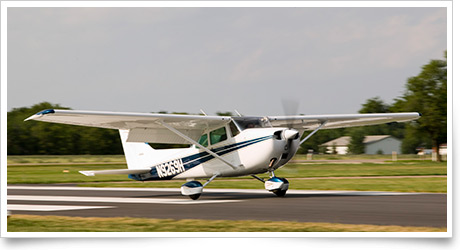| The following stories from the July 06, 2012, edition of AOPA ePilot were provided to AOPA members who expressed an interest in the particular subject areas. Any AOPA member can receive information tailored to their areas of interest by updating their preferences online |
training tipsA prudent precaution
Dramatic scenario? Not outlandishly so when you study accounts of pilots who found themselves facing tough choices. Encounter only one of the circumstances given above, and your careful flight planning will get you home. But run into them in combinations, and now a routine flight is anything but.
Fortunately, the trainer is running beautifully, and the next checkpoint (if it ever shows up!) is an airport with a long runway and, presumably, fuel is available.
This is no time to push things if you are running the fuel numbers and getting a question mark for an answer. The better choice is to make a precautionary landing, fuel up, and figure out Plan B in the safety and comfort of the fixed-base operation. (Chances are, there’s someone there who will be glad to help.)
As distinguished from an emergency landing—a term that gets loose usage in media accounts and nonpilot conversation—a precautionary landing is basically a pilot’s choice when uncertainty, or a problem that has not yet reached troublesome proportions, makes it prudent to land at the next reasonable opportunity.
Reasons might include a trend on an engine gauge; a rough-running engine that isn’t remedied by carb heat, diagnosing a magneto problem, or other usual means; or deteriorating weather, and they might appear alone or in ugly combinations.
It’s a judgment call, but focus on what’s important to manage risk. Screen out external pressures such as the potential inconvenience of being stranded, or any impatient people waiting for the aircraft.
Do let your home base know the situation promptly after you land—or before that, by radio, conditions permitting. If you are flying on a VFR flight plan, remember to notify flight service.
Whatever disruptive effects your precautionary action has on the plans of others, count on this: They are glad that you are on the ground, safe, and they applaud your decision.
CLARIFICATION: A quote in the June 29 Training Tip cited a definition of severe thunderstorm that has since been revised. Among other criteria, it now may have hail at least one inch in diameter. training productsASA Private Oral Exam GuideAviation Supplies & Academics Inc. (ASA) has released an updated version of its Private Oral Exam Guide. A new chapter on scenario-based training was written by 2009 Flight Instructor of the Year Arlynn McMahon. The new content is intended to provide insight into open-ended questions. The guide utilizes a question-and-answer format to list questions most likely to be asked by an examiner. Each question includes a reference to the FAA source from which the answer is derived. The softcover 256-page book is $12.95 and may be ordered online or by calling 800/272-2359.
Note: Products listed have not been evaluated by ePilot editors unless otherwise noted. AOPA assumes no responsibility for products or services listed or for claims or actions by manufacturers or vendors. final examQuestion: I am getting close to being ready to take the FAA airman knowledge test for the private pilot. Where can I find a list of computer testing sites?
Answer: There are two private companies that the FAA has contracted with to administer airman knowledge tests. Computer Assisted Testing Service (CATS) and PSI/LaserGrade combined have more than 700 test sites across the United States and around the world. The FAA maintains a list of testing sites on its website. The list contains the name of the city in which the site is located as well as the street address, phone number, and name of the testing facility. The FAA website also contains a sample of the questions you can expect on the knowledge test.
Got a question for our technical services staff? Email [email protected] or call the Pilot Information Center, 800/872-2672. Don’t forget the online archive of “Final Exam” questions and answers, searchable by keyword or topic. |

 It’s getting late in the day. It was a rude shock to discover that a
It’s getting late in the day. It was a rude shock to discover that a 

